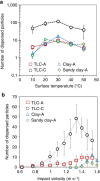Bioaerosol generation by raindrops on soil
- PMID: 28267145
- PMCID: PMC5344306
- DOI: 10.1038/ncomms14668
Bioaerosol generation by raindrops on soil
Abstract
Aerosolized microorganisms may play an important role in climate change, disease transmission, water and soil contaminants, and geographic migration of microbes. While it is known that bioaerosols are generated when bubbles break on the surface of water containing microbes, it is largely unclear how viable soil-based microbes are transferred to the atmosphere. Here we report a previously unknown mechanism by which rain disperses soil bacteria into the air. Bubbles, tens of micrometres in size, formed inside the raindrops disperse micro-droplets containing soil bacteria during raindrop impingement. A single raindrop can transfer 0.01% of bacteria on the soil surface and the bacteria can survive more than one hour after the aerosol generation process. This work further reveals that bacteria transfer by rain is highly dependent on the regional soil profile and climate conditions.
Conflict of interest statement
The authors declare no competing financial interests.
Figures







 =C*
× ɛ−1 with respect to non-dimensional surface temperature, T*, which is the ratio of the surface temperature T to the critical surface temperature Tc, where C* is the ratio of the dispersed cell density to the surface cell density, ɛ is the aerosolization efficiency obtained from a, and Tc is the surface temperature at which the maximum dispersed cell density is obtained. (c) Normalized cell density with respect to the dimensionless impact velocity, which is the ratio of the impact velocity V to the critical impact velocity Vc at which the maximum dispersed cell density is obtained. For b,c, six types of soils, two kinds of reference surfaces, three different species of bacteria, and two different sizes of microspheres were used as shown in Table 1. The red lines in b,c indicate the polynomial fitting lines. The error bars represent±1 s.d. resulting from more than 90 drop impingements. (d) Average aerosolization efficiency of three kinds of soil bacteria on four different soils and a reference surface (Table 1). On Sand-A and Sand-B, no bioaerosol was observed. The error bars represent±1 s.d. resulting from nine drop impingements.
=C*
× ɛ−1 with respect to non-dimensional surface temperature, T*, which is the ratio of the surface temperature T to the critical surface temperature Tc, where C* is the ratio of the dispersed cell density to the surface cell density, ɛ is the aerosolization efficiency obtained from a, and Tc is the surface temperature at which the maximum dispersed cell density is obtained. (c) Normalized cell density with respect to the dimensionless impact velocity, which is the ratio of the impact velocity V to the critical impact velocity Vc at which the maximum dispersed cell density is obtained. For b,c, six types of soils, two kinds of reference surfaces, three different species of bacteria, and two different sizes of microspheres were used as shown in Table 1. The red lines in b,c indicate the polynomial fitting lines. The error bars represent±1 s.d. resulting from more than 90 drop impingements. (d) Average aerosolization efficiency of three kinds of soil bacteria on four different soils and a reference surface (Table 1). On Sand-A and Sand-B, no bioaerosol was observed. The error bars represent±1 s.d. resulting from nine drop impingements.References
-
- Lighthart B. & Mohr A. J. Atmospheric Microbial Aerosols Theory and Applications Springer (1994).
-
- Knopf D. A., Alpert P. A., Wang B. & Aller J. Y. Stimulation of ice nucleation by marine diatoms. Nat. Geosci. 4, 88–90 (2011).
-
- Douwes J., Thorne P., Pearce N. & Heederik D. Bioaerosol health effects and exposure assessment: progress and prospects. Ann. Occup. Hyg. 47, 187–200 (2003). - PubMed
-
- Harrison M. D. Aerosol dissemination of bacterial plant pathogens. Ann. N. Y. Acad. Sci. 353, 94–104 (1980).
Publication types
MeSH terms
Substances
LinkOut - more resources
Full Text Sources
Other Literature Sources
Molecular Biology Databases

